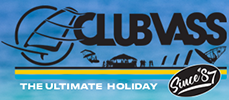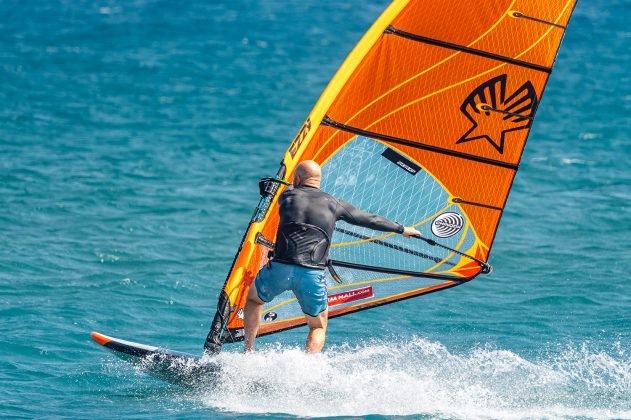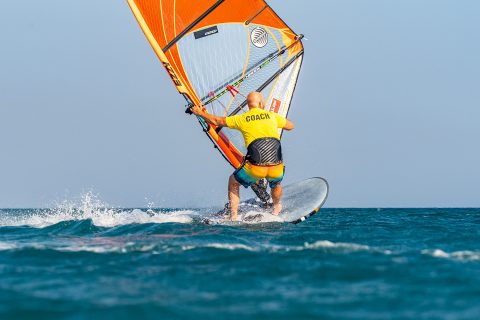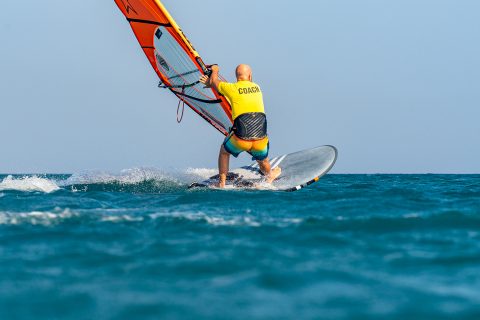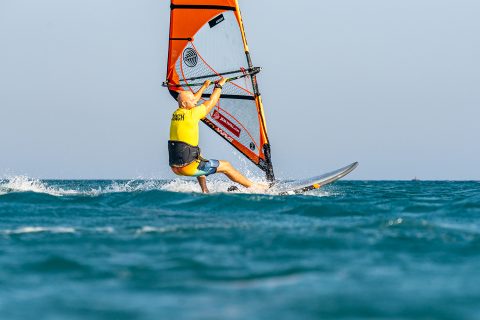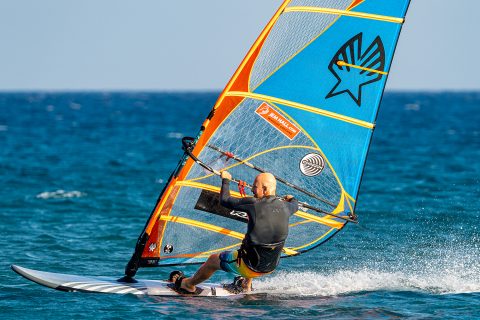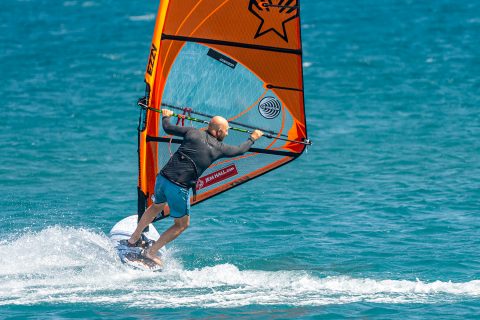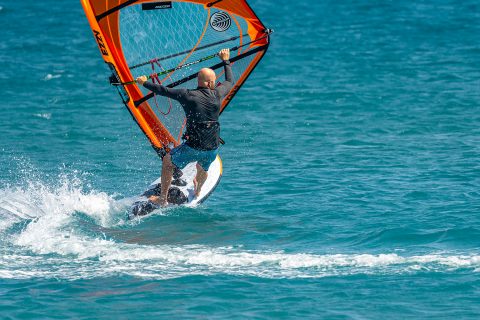JEM HALL
MOVE ON UP – WINDSURFING TECHNIQUE
CRACK THE PLANING CARVE GYBE
MOVE ON UP: JEM HALL – CRACK THE PLANNING CARVE GYBE
Jem Hall uses the knowledge imparted from the planing tack and duck gybe to help you crack the holy grail… the planing carve gybe.
Words: Jem Hall // Photos: Eye Sea You
This month we look at the planing carve gybe, which will see you calling upon the skills, and tips, I highlighted in my earlier articles on both the planing tack and duck gybe. I will present my top tips at each phase of the gybe, that you can work on as you look to unlock one of the most aspirational moves in our sport. These phases consist of; preparation, carving, mid-gybe, active exit, and planing out. You can work on and look to improve each phase individually and then when you tie them all together you will be flying out of your gybes in no time.
PREPARATION
All of the above phases are key, but the preparation phase is the one that gives you that crucial aspect that you must possess when you enter a gybe, especially if you want to have any chance of planing out… speed. Take speed in, and you will inevitably be able to come out of a gybe with speed too. All the phases need “power and precision’, but along with the planing exit, the preparation phase places the most pressure on your physicality, so, as ever, the fitter and stronger you are, the better you will be at entering gybes at speed, which again means you’ll have a higher chance of planing out.
Below is a quick refresh of some of the technique for this phase from my “Preparation” piece from June 2015, and the update of this from March 2023, aptly entitled, “Better Gybing”.
- Back, Back, Back: Get your front hand back to help you get your backhand back, and when the back foot comes out of the strap, it should be placed next to the back strap (mid-board), and then slid all the way over to the rail for carving after you have scissored the board to gain speed.
- Bend to Unhook: Bend your back leg and ONLY bend your elbows to unhook. This keeps you low and out so you can maintain speed once unhooked.
- Get Speed: After your H.U.F. (hands back, unhook, foot out of back strap) prep, stay out so you can scissor the board downwind in order to increase your speed, and thereby lighten the sail, so you can ‘go with it’. The board remains flat and it is the pushing with your front leg, and pulling with your back leg, that performs this.
- Comfy with Discomfort: Get used to going fast over the back of chop and you will eventually become accustomed to the technique, and mindset, required to take speed into your carving.
Work on this phase A LOT! You can even work on it before you can actually gybe. Just do it and then head upwind and jump in the sea, or try a tack. This makes you focus on your prep and speed.
- Reach under and collect the new side of the boom with an overhand grip as you keep low and carve off the heels.
- Slide that mast hand to the front of the boom, look forward, be out and low.
- Drive the rig forward and get your hands next to the lines as you pull down on the boom and push the board forward through a straight front leg and bent back leg.
CARVING
Strangely enough the name ‘carve gybe’ makes you think you will be carving throughout most of the move, yet the initial carve is over in a flash. This phase takes your prep speed and allows you to drive forward and engage the rail, so you can lock the board into a carve and maintain momentum. My main tips here are:
- Mini Catapult: To get from sailing outboard in the scissoring phase, to driving forward to carve, you have to ‘go with the sail’ and this is best done by tipping the rig slightly forward and across you with the front hand, and sheeting in a little on the back foot. This pulls you forward and then you really have to ‘go with it’.
- Extend and Bend: As you ‘go with it’ aim to really extend your front arm to lock the board down and bend your ankles and knees to engage the rail.
- Feel the Front Foot: Look to get some pressure on the front foot – even if only briefly.
- Not Too Much: Having the backhand back sheets the rig in just enough, don’t try and really sheet it in, nor lay it down, as this will make the mid-gybe phase waaaaay harder.
MID GYBE
This occurs when the board is going dead downwind and it really is all change here. Repeat, feel and perform these actions:
- See the Sea, See the Clew: You are looking to see the sea, by driving the rig forward and going with it, and then mid-gybe, it is all about opening the sail and moving your hips across. This is best achieved by shifting your vision to actually see the clew. Backhand back really assists this action.
- Extend and Bend: What? Again? Yes indeed, extend those arms and really bend your back leg, like you are moving your back knee towards the water. Licking the boom is really not de-rigueur at this stage!
- Out and Across: Seeing the clew will help you get your rig out and thereby your hips can move across to the inside of the gybe. This lightens your front foot so it is ready to complete the foot change.
- Low, fast and outboard, and ready to unhook by bending your elbows gives you the speed you need.
ACTIVE EXIT
This is the phase where I see most people become passive, rather than active, and yet by being dynamic, it is the area where you can manipulate a slower gybe into a planing one. It requires plenty of physicality, excellent vision and definitely no gear gazing. These are my tips:
- Take it: If your hips have moved across, and you are low mid-gybe, then they are ready to take some power clew-first. Believe me here, you need to sail clew-first out of the gybe, but as you improve your gybes you can look to execute an earlier rig flip. This will give you some exit speed and also put you in a position to ‘carve it out’. It will also give you ‘time to slide’.
- Extend and Bend: Have your arms extended and back leg very bent as you ‘take it’.
- Time to Slide: When clew-first pull down on the clew hand, so the mast hand becomes lighter, so you then have the time to slide it to the front of the boom. This will give you a more efficient rig rotation as you move to the next action.
- Carve it Out: This part is huge. Many carve into a gybe, yet few carve out! If you are low and outboard with your new back foot near the rail, then you are in an awesome position to carve out on your heels, as you send the rig back. This gets you back across the wind, so you can grab the rig with less danger of catapulting.
- Look and Go Under: As you carve out of the gybe, it is so important to be out, low and looking forward as then your old backhand can reach under and grab the new side of the boom with an overhand grip.
- Low in, through and out the gybereally is the key to planning gybes.
- See your exit and the clew, keep the rig away and pull down on the boom
PLANING OUT
You will have honed plenty of core skills from looking to plane out of tacks, and duck gybes, so now it is time to use these. If you have come out of the gybe with some momentum then it will be much easier to get the board back to planing speed. You are looking to make the transition between coming out of the gybe moving and then getting planing to become relatively seamless. Again, you can practice this getting planing skill by learning to plane from the front strap and then hooking in afterwards. This can be worked on after a waterstart, tack, duck gybe, gybe or wave catch etc. The main tips here are:
- Throw Rig Forward: Once you have the rig on the new side throw it forward, and let the boom slip through your fingers so your front hand is beside the front line. This is covered in my “Handy Hints” piece from June ’22.
- Get Down James Brown: Extending (your arms) and bending (your back leg), together with a relatively narrow grip really gives you the maximum power from the rig. These actions will catch more wind, allowing you to drive the board forward through a straight front leg, while really pulling down on the boom.
- Strap it Up: Take this momentum and get in that front strap first. Hooking in too early risks a fall, is lazy, and stalls the sail.
- Two or One? If it is windy and you are coming out with plenty of power then I suggest getting in both the front and back straps before hooking in. With less power, go for just the front strap until you get up to speed.
- Stable Hook: From the strap(s), you can then look to plane relatively far off the wind, and then come back across the wind to hook in. Your rig likes you to hook in and out across the wind, so be nice to her.
- Arms together, looking forward, pulling down on the boom and bending the back leg, whilst pushing through the front foot gives you the best chance of planing out.
Ezzy Sails, RRD (boards, wetsuits & softwear), Chinook & Black Project Fins sponsor Jem Hall. Get him live and direct on one of his highly acclaimed coaching holidays – check out his website www.jemhall.com for details. You can also follow him on X / Facebook / Instagram.

